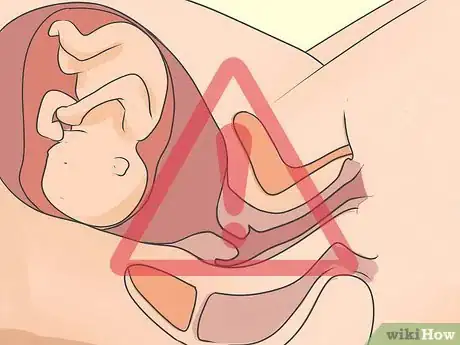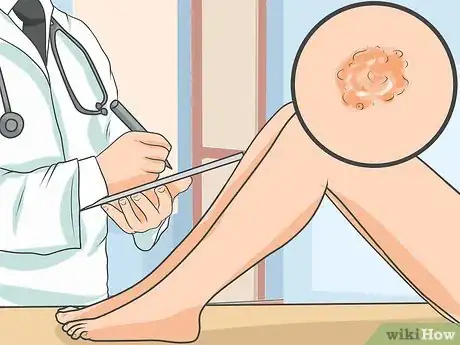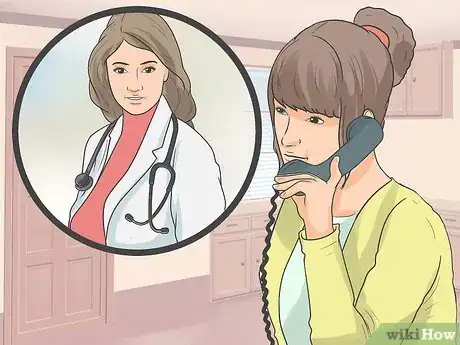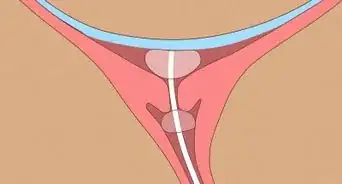This article was co-authored by Carrie Noriega, MD and by wikiHow staff writer, Hannah Madden. Dr. Noriega is a Board Certified Obstetrician & Gynecologist and medical writer in Colorado. She specializes in women’s health, rheumatology, pulmonology, infectious disease, and gastroenterology. She received her MD from the Creighton School of Medicine in Omaha, Nebraska and completed her residency at the University of Missouri - Kansas City in 2005.
There are 21 references cited in this article, which can be found at the bottom of the page.
This article has been viewed 145,663 times.
You may want to experience natural childbirth so you feel engaged in the process or to avoid unnecessary medical treatments. Having a natural childbirth means that you deliver your baby without medical intervention, such as pain medication or a c-section. With proper planning and support, you can likely have a natural birth. However, work closely with your doctor and get medical treatment immediately if complications occur.
Steps
Researching Your Options
-
1Determine whether a natural birth is possible for you. Natural childbirth is not always an option. Certain health conditions, such as preeclampsia and gestational diabetes, may make a natural birth more difficult or risky for you.[1]
- If you have a high-risk pregnancy, consult a medical professional about your ability to have a natural birth. In some cases, you may be able to give birth naturally as long as you are monitored for complications.
-
2Consider the benefits of natural birth. Arming yourself with the positive reasons for having a natural birth can help keep you motivated throughout the birth process. Some of the reasons that you may want to consider a natural childbirth include:[2]
- A natural birth can save both you and your baby from the stress and unpleasant side effects of medication, surgery, and physical intervention. Many women who are guided through a natural birth also report less pain, anxiety, confusion, and stress than women undergoing births with medical intervention.
- Natural birth can provide a more personal experience that focuses on the overall well-being of mother and baby.
- Because you will be fully aware during the birth, you may remember it better and be able to enjoy it more.
- Having a natural birth reduces the chances that you will need a Cesarean section.
- Women who have natural births also tend to recover faster.
Advertisement -
3Know the risks of natural birth. Although natural births have long been the norm, natural birth may put you at an elevated risk for complications.[3]
- Natural birth may pose some danger to you if you have other health conditions if you are not attended by a health professional if you are not in proximity to a medical facility in case of emergency and if the baby presents in a challenging position.
- Remember that it's okay if you end up deviating from your plan and do not achieve natural childbirth. There is no shame in this, and it is not a failure. The most important thing is doing what is best for you and your baby, and at times this may mean not doing natural birth.
-
4Keep in mind that medical interventions may be necessary for certain situations. Even with careful planning and the best prenatal care, situations may arise during childbirth that require medical interventions. Some reasons why medical intervention may be necessary include:[4]
- Misplaced placenta (placenta previa)
- Active herpes infection or HIV infection
- Previous C-section deliveries
- Baby will not tolerate labor
- Induction of labor for the health of the mother or the baby
Deciding Where to Give Birth
-
1Evaluate your ability to have a natural birth at the hospital. In some hospitals, medical staff is supportive of natural births and may have trained midwives or natural birthing staff to attend your birth. Research your options and visit your local hospital to ask questions and determine how well it would support a natural birth.[5]
- If you are a high-risk pregnancy but would still like to attempt a natural birth, you may wish to deliver at a hospital so that medical assistance is immediately available should it become necessary.
- Some hospitals have natural birth centers on-site that allow a natural birth experience in an environment that feels less like a hospital, but still allows expert medical care to be in close proximity.
- Talk to the nursing staff at the hospital about your options. Look for things like bathtubs for soaking during labor and birthing balls in the rooms.
-
2Search for birth center options in your area. Many birth centers specifically design their facilities for natural birth support. They also have expert staff who are familiar with the natural birth process and who are committed to helping women experience natural labor.[6]
- Ask the birth center about the amenities they have including options they offer for delivering your baby, such as in a bed or in water.
- Request information on the qualifications of delivery staff and the center’s ability to offer care in emergency situations.
-
3Consider a natural home birth. Many women find that a home birth allows for the optimum level of comfort, relaxation, and empowerment during a natural birth. If you are a low-risk pregnancy and are able to have a birthing doula and midwife present, a home birth may be a safe and pleasant way to have a natural birth.[7]
Preparing for the Natural Birth Process
-
1Choose a practitioner. Before you go any further with your plans to have a natural birth, you should choose your team. An obstetrician (OB/GYN), certified nurse-midwife, perinatologist, or family practitioner are all qualified to help you deliver your baby. Each one has a different level of training and specialization, so it is important to consider your situation before you choose. Some differences to consider include:[8] If your pregnancy is high-risk, a perinatologist could deliver your baby.
- OB/GYNs are doctors who can deliver your baby as well as provide surgical care if necessary.
- Certified nurse-midwives are qualified to deliver your baby and they will call on an OB/GYN if complications arise.
- Perinatologists are doctors who are qualified to deliver your baby and who provide care for high-risk deliveries, such as women over 35, women who have STDs, and women who have diabetes.
- Family practitioners are doctors who are qualified to deliver your baby, but they are not specialists, so they will call on an OB/GYN if complications arise.
-
2Ask questions before you decide on a practitioner. As you consider who will help deliver your baby, make sure that you ask questions to determine whether the person will be supportive of your plans to have a natural childbirth. Some questions to ask include:[9]
- How do you feel about natural childbirth?
- How many natural births have you been involved in?
- Would you be willing to help me have a natural birth?
-
3Create a birth plan. Every expecting mother should have a birth plan that expresses her needs and desires for the birth of her child. You should work with your support team to create a birth plan. Ask your doctor, midwife, or doula to assist you in writing a birth plan. Your birth plan should include:[10]
- Where your baby will be born
- Who will deliver your baby
- Who your main support person will be
- Who else may be present during labor and birth
- Types of support that you want during labor
- Any pain medications that you want during labor
- Details about the umbilical cord and blood
- Will the baby stay with you or in the nursery after birth
- Any special traditions you would like to observe
- Who to tell first if there is a problem with you or the baby
- Anything else you want your health care provider and support team to know
-
4Designate a birth advocate or birth partner. For most women, it is easier to maintain your decision to have a natural birth if you have a partner or advocate. This person should be someone who will remind you of your reasons for a natural birth and who will be there to support you during the birth.[11]
- If you give birth in a hospital, a vocal advocate or a professional doula may help you stand up for your wishes if medical staff seems resistant to your plan.
- Having a birth advocate or partner can also help give you the encouragement and support you need to have a birth free of interventions, medications, or surgery.
-
5Inform your midwife or health care provider of your wishes. Deciding in advance to have a natural childbirth will allow your health care provider and birth assistant time to plan for your safety and that of the baby. It will also enable you to ask questions and arrange for your preferences to be accommodated no matter where you give birth.[12]
-
6Take a class on natural childbirth. Learning about natural birth from women who have experienced it and even facilitated it for others can be the most informative and helpful preparation for your own natural birth experience.[13]
- Discuss your fears, anxieties, and hopes with other women in the class. In many cases, women who have delivered naturally before can set you at ease about pain management and medical safety.
Managing Labor Pain Without Medication
-
1Use breathing exercises. Breathing exercises are a common form of relaxation and pain relief for women who desire to have a natural birth. The best way to learn breathing exercises prior to giving birth is to take a special birthing class. Choose one that focuses on breathing techniques.[14]
- Look into Lamaze and the Bradley Method. Both methods teach breathing techniques to help minimize pain and to help you stay relaxed during childbirth.
- Some women find it helpful to pair a word or phrase with breathing to help them focus. For example, as you inhale you might think to yourself “Keep” and then as you exhale you might think “Calm.” Repeating this over and over as you breathe will help you to stay focused and calm.
-
2Try visualization exercises. Finding a focal point or imagining a peaceful scene can help you to relax and manage pain during labor. For example, you might bring a photo to use as your focal point and focus your eyes on that image during your contractions. Choose an image that helps you to feel calm, such as a photo of a beautiful sunset. Or, you can close your eyes and imagine a peaceful scene. For example, you might picture yourself sitting on a beach or standing on top of a mountain.[15]
- Meditation can help improve your visualization skills and it is also an effective way to deal with pain during labor. Consider taking meditation classes prior to giving birth to help improve your visualization technique.
- Hypnobirthing is another good way to use visualization techniques. Hypnobirthing uses self-hypnosis to help you cope with pain during labor. There are classes and voice-directed programs that teach this technique. You can put the voice-directed programs on a portable media player and take this with you to listen during labor.
-
3Change positions and move around. Listening to your body and changing positions often during childbirth can help you to feel more comfortable. If you feel the need to walk, sit, lay down, recline in the tub, or lean against something, then do it.[16]
-
4Get a massage. Getting a massage from your doula or your partner during childbirth can be a great way to relax and take your mind off of the pain. Sometimes, however, you may find it annoying for someone to touch you during childbirth, so don’t be afraid to let your birth partner know if this is the case.[17]
-
5Use hot or cold therapy. Using heating pads to relax your muscles may help to provide some relief, as may using cold packs to numb certain areas. You may even want to switch back and forth between hot and cold packs during labor. Make sure that the hot and cold packs are wrapped in towels and that you are not placing them directly on your skin.[18]
-
6Immerse yourself in a bath or take a shower. Taking a bath during labor can help to relax your muscles and reduce pain during labor. Even taking a shower during labor can help you to relax. If you have the option of water birth, then this is something to consider as well.[19]
- Make sure that the tub is kept at body temperature (98.6°F or 37°C).
-
7Try a TENS unit. Transcutaneous Electrical Nerve Stimulation (TENS) uses a handheld device that connects to several sticky pads that are applied to your skin (you'll want to stick them to your back for labor pains). The machine sends small pulses of electrical current to the pads, which penetrate to your muscles. You can control the frequency and strength of the pulses.[20]
- To use a maternity TENS machine, have your partner apply the pads to your back. You'll want them evenly spaced on either side of your spine. Place the top two pads at about where your bra band would hit, and the other two on your lower back, just above your butt.
- Start with the machine on the lowest setting and turn it up as pain increases.
- Your machine may have a "boost" button, which will cause the machine to immediately switch into the highest, most intense setting. Use this button at the peak of your contractions.
- It may take at least an hour for TENS to start working.
-
8Consider acupuncture or acupressure. Acupuncture uses needles which are inserted into specific points on the body to provide pain relief. Acupressure is a similar method but pressure is applied instead of needles. If you are interested in having acupuncture or acupressure during labor, you will need to enlist the services of a certified acupuncturist or acupressurist.[21]
When to Seek Medical Care
-
1Check with your doctor to make sure a natural birth is safe for you. A woman’s body is designed to give birth, so many women can safely give birth without medical intervention. However, you may need medical treatment if your pregnancy is high risk or you develop complications. Discuss your medical history and options with your medical team to find out what’s best for your pregnancy.[22]
- If you don’t agree with your doctor’s recommendations, get a second opinion to be sure.
- While childbirth is natural, it can still be risky. Your doctor can help you understand those risks so you know what to expect.
-
2Work closely with your doctor to make sure you have a healthy delivery. While you might avoid medical interventions while you’re giving birth, your doctor or medical practitioner will help you throughout your pregnancy and delivery. Keep them updated on your progress and listen to any advice they offer. Once you go into labor, trust them to help you and your baby have the healthiest delivery possible.[23]
- In some cases, your doctor may suggest that you change your birth plan due to potential complications. If this happens, your birth advocate or birth partner can help you consider your doctor’s reasons and figure out what’s best for you.
-
3Get immediate medical care if you have complications. Sometimes complications happen during delivery that might put you or your baby at risk. Try not to worry if this happens because your medical team can help. Let your doctor or medical practitioner do any medical interventions necessary to help you deliver safely.[24]
- If you’re at home, you’ll likely need to move to the hospital if you’re having complications. Try not to worry because your medical team is prepared to handle this situation.
- If you’re already at the hospital, your team will start your treatment as soon as the complications start.
-
4Talk to your doctor if you have excessive pain or bleeding after delivery. It’s normal to have bleeding and discomfort after you give birth. However, serious pain and bleeding may be a sign that something is wrong. Try not to worry because you’re likely okay, but call your doctor to find out if you need treatment.[25]
- If you have a fever or abdominal tenderness, you may have an infection or could need medical treatment.
- Bleeding is considered excessive if you’re soaking through more than 1 pad in an hour.
Warnings
- In some cases, a natural birth is impossible without risking the health of you or your baby. This does not mean you have failed; take comfort in the knowledge that you did what was necessary for a safe delivery of your baby, and concentrate on making his or her infancy everything you planned.⧼thumbs_response⧽
- Even if you anticipate a safe delivery, certain unforeseeable circumstances may require emergency medical assistance. Have a backup plan for getting yourself needed care in a worst-case scenario.⧼thumbs_response⧽
References
- ↑ https://www.nichd.nih.gov/health/topics/high-risk/conditioninfo/factors
- ↑ https://www.ncbi.nlm.nih.gov/pmc/articles/PMC1595040/
- ↑ https://www.nichd.nih.gov/health/topics/high-risk/conditioninfo/factors
- ↑ http://www.aafp.org/afp/2008/0801/p336.html
- ↑ https://www.beebehealthcare.org/health-hub/womens-health-blog/have-natural-birth-hospital
- ↑ https://kidshealth.org/en/parents/natural-childbirth.html?ref=search
- ↑ https://www.whattoexpect.com/pregnancy/home-birth/
- ↑ https://medlineplus.gov/ency/patientinstructions/000596.htm
- ↑ https://www.whattoexpect.com/pregnancy/your-health/prenatal-care-doctors
- ↑ http://www.marchofdimes.org/materials/birth-plan.pdf
- ↑ https://www.who.int/reproductivehealth/companion-during-labour-childbirth/en/
- ↑ https://newsnetwork.mayoclinic.org/discussion/the-importance-of-a-birth-plan/
- ↑ https://kidshealth.org/en/parents/childbirth-pain.html
- ↑ https://kidshealth.org/en/parents/childbirth-pain.html
- ↑ https://www.beaumont.org/treatments/breathing-exercises-visualization
- ↑ https://www.tommys.org/pregnancy-information/giving-birth/movement-and-positions-during-labour
- ↑ https://kidshealth.org/en/parents/childbirth-pain.html
- ↑ https://www.parents.com/pregnancy/giving-birth/vaginal/dos-and-donts-of-natural-childbirth/
- ↑ http://brochures.mater.org.au/brochures/mater-mothers-hospital/labour-and-birth-warm-water-immersion-and-water-bi
- ↑ https://www.ncbi.nlm.nih.gov/pubmed/9544709
- ↑ https://www.mayoclinic.org/healthy-lifestyle/labor-and-delivery/in-depth/labor-pain/art-20044845
- ↑ https://www.nichd.nih.gov/health/topics/high-risk/conditioninfo/factors
- ↑ https://www.mayoclinic.org/healthy-lifestyle/labor-and-delivery/in-depth/stages-of-labor/art-20046545
- ↑ https://www.nichd.nih.gov/health/topics/labor-delivery/topicinfo/complications
- ↑ https://www.mayoclinic.org/healthy-lifestyle/labor-and-delivery/in-depth/postpartum-care/art-20047233



















































































Medical Disclaimer
The content of this article is not intended to be a substitute for professional medical advice, examination, diagnosis, or treatment. You should always contact your doctor or other qualified healthcare professional before starting, changing, or stopping any kind of health treatment.
Read More...